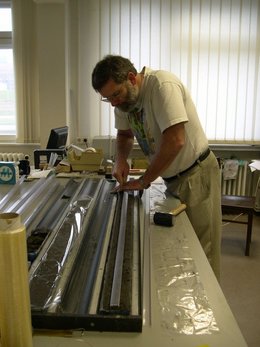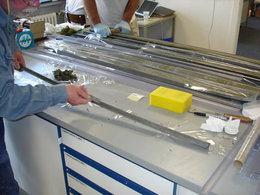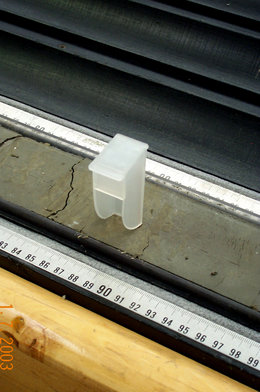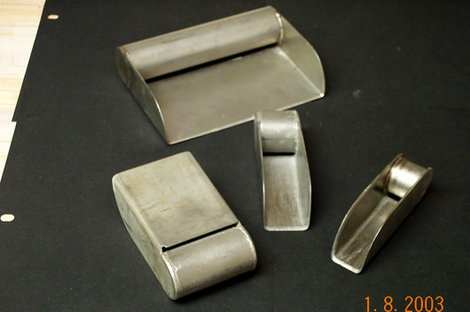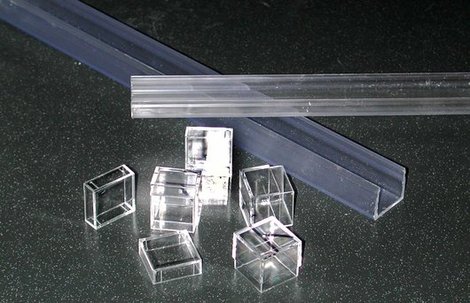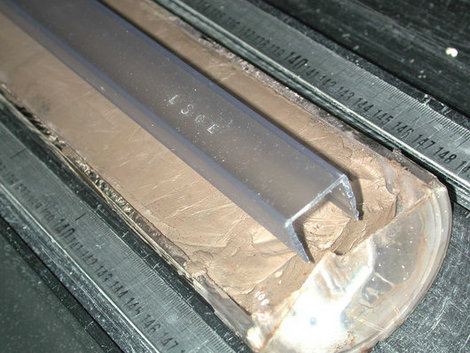Die Inhalte dieser Seite sind leider nicht auf Deutsch verfügbar.
Seitenpfad:
Sampling of Cores
Planning and organization of Science Party Sampling
The Onshore Science Party is considered to be part of the actual expedition, where the entire group of expedition scientists meets for the first time. The cores are split, described, and analyzed according to the IODP minimum and standard measurements. In addition the science party takes the samples for expedition-related analyses and for individual post-cruise research projects according to the moratorium sampling plan. All this work is carried out in the IODP laboratories of the BCR in the MARUM buliding.
- The Sample Allocation Committee (SAC), comprising the Co-chief scientists, the ESO staff scientist, and the IODP Curator, meet before arrival of the Science Party to review and evaluate the submitted sample and data requests. The goal of this meeting is to make sure that the scientific objectives of the expedition as represented in the proposed research projects are met, and also to identify potential overlap of or conflicts between different requests.
- On the first day of the Onshore Science Party, the SAC discusses the sample and data requests with the different groups (e.g., micropaleontologists, geochemists, petrophysicists, sedimentologists, etc.) and in the case of overlap they try to resolve the potential conflicts.
- The SAC then develops a specific sampling plan to be carried out through the course of the science party. This involves establishing the volume of each sample as well as the precise placement of samples for each investigator within each section, depending on the stratigraphic interval required, and the spacing between individual samples. Good planning at this stage is critical so that when possible each section must only be opened once to get all samples for all of the investigators.
All sampling follows the IODP Sample, Data, and Obligations Policy.
Three general sampling types are discussed:
Hard Rocks, Sediments, and Paleomagnetism Samples:
The Onshore Science Party is considered to be part of the actual expedition, where the entire group of expedition scientists meets for the first time. The cores are split, described, and analyzed according to the IODP minimum and standard measurements. In addition the science party takes the samples for expedition-related analyses and for individual post-cruise research projects according to the moratorium sampling plan. All this work is carried out in the IODP laboratories of the BCR in the MARUM buliding.
- The Sample Allocation Committee (SAC), comprising the Co-chief scientists, the ESO staff scientist, and the IODP Curator, meet before arrival of the Science Party to review and evaluate the submitted sample and data requests. The goal of this meeting is to make sure that the scientific objectives of the expedition as represented in the proposed research projects are met, and also to identify potential overlap of or conflicts between different requests.
- On the first day of the Onshore Science Party, the SAC discusses the sample and data requests with the different groups (e.g., micropaleontologists, geochemists, petrophysicists, sedimentologists, etc.) and in the case of overlap they try to resolve the potential conflicts.
- The SAC then develops a specific sampling plan to be carried out through the course of the science party. This involves establishing the volume of each sample as well as the precise placement of samples for each investigator within each section, depending on the stratigraphic interval required, and the spacing between individual samples. Good planning at this stage is critical so that when possible each section must only be opened once to get all samples for all of the investigators.
All sampling follows the IODP Sample, Data, and Obligations Policy.
Three general sampling types are discussed:
Hard Rocks, Sediments, and Paleomagnetism Samples:
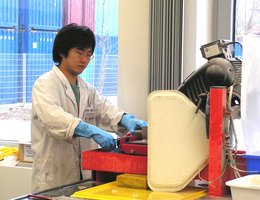
Hard rocks
Hard-rock sampling is usually carried out using a rock saw or a drill.
Various shaped samples can be cut with the saws, using blades of different thickness or diameter, depending on the purpose of the sample and hardness of material. For most sampling with the saw, the sample is hand-held and cut to shape as needed.
Drilling uses a cylindrical bit, usually with a one-inch inside diameter, but smaller diameter bits are also available. Hard-rock samples for paleomagnetic analyses (mini-cores) are often taken using the cylindrical drill bits. Mini-cores are most commonly drilled perpendicular to the long axis of the core, and perpendicular to the cut face of the core.
Both sawing and drilling techniques require a water source for cooling the cutting tools.
Hard rocks in marine geology are usually considered to be igneous ocean crustal rocks such as basalt or gabbro. The same sampling techniques, however, are employed in the lab for massive coral skeletons and indurated sedimentary rocks.
Various shaped samples can be cut with the saws, using blades of different thickness or diameter, depending on the purpose of the sample and hardness of material. For most sampling with the saw, the sample is hand-held and cut to shape as needed.
Drilling uses a cylindrical bit, usually with a one-inch inside diameter, but smaller diameter bits are also available. Hard-rock samples for paleomagnetic analyses (mini-cores) are often taken using the cylindrical drill bits. Mini-cores are most commonly drilled perpendicular to the long axis of the core, and perpendicular to the cut face of the core.
Both sawing and drilling techniques require a water source for cooling the cutting tools.
Hard rocks in marine geology are usually considered to be igneous ocean crustal rocks such as basalt or gabbro. The same sampling techniques, however, are employed in the lab for massive coral skeletons and indurated sedimentary rocks.
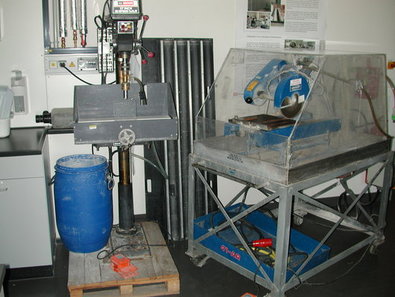
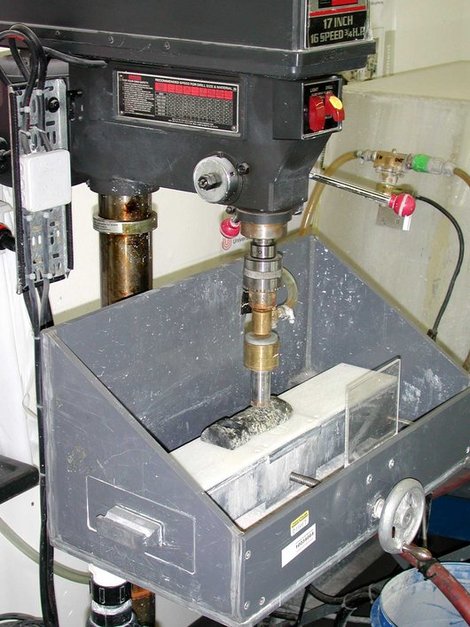
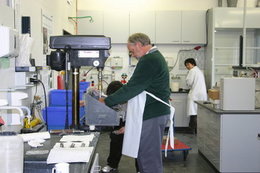
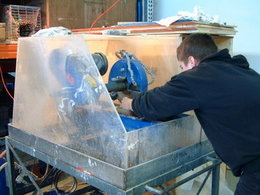
Sediments
For the purposes of describing sampling techniques, sediments are considered to be those sedimentary units that are soft enough to be sampled without the use of the saw or drill.
For the softest sediments, usually the most efficient technique makes use of plastic receptacles for relatively standard sample sizes of 5 or 10 cc. They are pressed into the soft sediment and removed with the sediment sample inside. There are two basic forms of these:
For the softest sediments, usually the most efficient technique makes use of plastic receptacles for relatively standard sample sizes of 5 or 10 cc. They are pressed into the soft sediment and removed with the sediment sample inside. There are two basic forms of these:
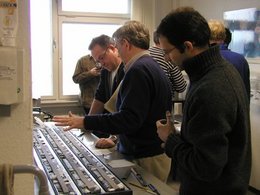
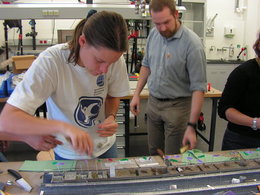
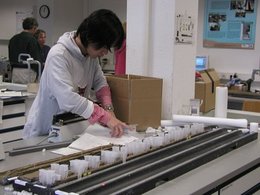
Paleomagnetic samples: u-channels and cubes
